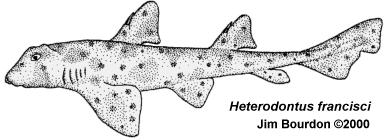| |
Along with some squaliforms, members of the genus Heterodontus are the only extant sharks with dorsal fin spines. They are a common, tropical to warm-temperate, bottom shark of the continental and insular shelf. Usually found in waters from intertidal to 100 meters (max 275 m), they mainly feed on benthic invertebrates - echinoids, crabs & other crustaceans, pelecypods, gastropods and polychaetes. Limited to the Pacific and Indian Oceans, Compagno et al (2005) includes nine extant species, two of which lie off Western North America -- H. francisci (GIRARD, 1854) and H. mexicansus TAYLOR & CASTRO-AQUIRRE, 1972.
 |
 As the name of the genus implies, the dentition is particularly heterodont and serves a clutching-grinding function. Anterior and posterior teeth are of significantly different design. The anteriors are small; the cusp broad and deep, and lateral cusplets are usually present. The labial face of the crown extends over the splayed root lobes and the apron may bear ornamentation. The root is low, bears a large foramen on the labial and lingual faces of the lingual protuberance, and is V-shaped when viewed basally. Anterior-most teeth are symmetrical, becoming less symmetrical (and root lobes further separated) in more distal positions.
As the name of the genus implies, the dentition is particularly heterodont and serves a clutching-grinding function. Anterior and posterior teeth are of significantly different design. The anteriors are small; the cusp broad and deep, and lateral cusplets are usually present. The labial face of the crown extends over the splayed root lobes and the apron may bear ornamentation. The root is low, bears a large foramen on the labial and lingual faces of the lingual protuberance, and is V-shaped when viewed basally. Anterior-most teeth are symmetrical, becoming less symmetrical (and root lobes further separated) in more distal positions.
Lateral teeth are significantly larger and much more reminiscent of the grinding myliobatoid tooth design. These teeth have a low root, are laterally elongated, have a transverse depression on the basal lingual face and may be weakly curved.
Cappetta (1987: 69-70) lists numerous fossil species from Europe, Africa, Australia and the Americas. There are no lack of taxa to which teeth can be ascribed -- as some species were erected based on a few damaged specimens without positional or ontogenetic considerations. Some authors associated these teeth with previously described European taxa while others (ie Müller 1999: 34 & Parmley et al 2003:158) took the more conservative approach - Heterodontus sp. Named possibilities include:
H. cf canaliculatus (DIXON 1850), reported by Welton and Farish (1993: 78-79) from Lower Coniacian - Campanian sediments (Upper Cretaceous) of Texas.
H. creamridgensis CASE, BORODIN & LEGGETT 2001, described for teeth from the New Egypt Fm. (L. Maas). of New Jersey. Case & Cappetta (2004: 8) also reported this taxon.
H. elongatus CASE & BORODIN, 2000b, erected for anterior and lateral teeth from the Castle Hayne Fm (Seq 2, Lutetian) of North Carolina.
H. granti CASE & CAPPETTA, 1997, erected for three small (1.5 - 2 mm class) anterior / antero-lateral teeth from the Kemp Clay (Maastrichtian) of Texas. The size and design of these teeth suggest they could represent juveniles and the species was erected without contrasting them with juveniles of the contemporaneous H. rugosus. This tooth-design can only be deemed questionable at this time and will be referred to as H. "granti".
H. jaqnefirdae CASE, 1980, erected for two damaged anterior teeth from Trent Fm (Oligocene) of North Carolina.
H. lerichei CASIER, 1943. A popular identification, Ward &; Wiest (1990) included them as occurring in Danian through Ypresian exposures (Brightseat, Aquia & Nanjemoy Formations) of Virginia and Maryland. Kent (1999: 14-15)) also used H. lerichei as present in the Nanjemoy fauna of Virginia.
H. pineti CASE 1981. erected for specimens (lerichei-like) from the Twiggs Clay, Barnwell "Fm" (Priabonian) of GA of Georgia. Parmley et al (2003:158) found their material inconclusive and attributed them the Heterodontus sp.
H. rugosus (AGASSIZ, 1839) was used by Manning & Dockery (1992:26-27) for Late Campanian specimens from the Demopolis Formation of Mississippi.
Late Cretaceous
There is an absence of reports of Heterodontus teeth from the Late Cretaceous of the East Coast. During this period they are known from Texas and the former Mississippi Embayment. Hamm & Cicimurri (2011) included Heterodontus sp in the Atco Formation (Early Coniacian) of Texas.
Aquia Formation -- Selandian
Heterodontus teeth are uncommon to scarce in the Aquia, but those specimens found are in relatively good condition and generally conform with the lerichei tooth-design.
Nanjemoy Formation -- Ypresian
Two, seemingly distinct, lateral heterodontid teeth are present in the Nanjemoy fauna. Originally deemed to be functional wear, it is now believed by the author that these teeth likely represent two species. According to Gilles Cuny (pers. com., 1999) the H. lerichei-design is typical of the francisci-group (Reif's plesiomorphic state) of heterodontids. However, it was his opinion that these tooth variations are solely the result of tooth position and wear.
Without careful attention, the first could be easily overlooked as a small, worn, myliobatoid tooth. The crown is rectilinear (higher in a medial position) and has a smooth and rounded crown. The roots, when viewed basally, are relatively symmetrical (Fig. ).
The second tooth design (Fig. ) is likely H. lerichei. Occlusally, the teeth are roughly rectilinear, often having a weakly S-shaped profile. The deepest (and highest) portion of the crown is often off-center. Depending on tooth position, the elongation of lateral teeth can vary greatly. (The largest studied tooth measured 17 mm in width. These teeth have been noted as having width-to-depth ratios of 2:1 to 5:1) A high transverse ridge is positioned lingual to the meso-distal midline of the tooth.
Viewed lingually, a deep depression runs transversely just above the base of the crown. Numerous strong enameloid ridges run apico-basally from the transverse crest to the top of the depression. Similar ridges run down the labial face, but they become smaller basally, branching and intersecting. The final result is a pitted appearance on the lower labial face.
Viewed laterally, the lingual face is quite erect above the transverse depression where it rises to form the crest. The labial face is weakly convex and gently slopes to the labial margin which overhangs the root.
Viewed basally, the roots do not extend beyond the crown and are asymmetrical in design. The root has a distinct lingual protuberance, which holds a large, lingually-directed, foramen. This protuberance corresponds with the high point of the crown. A crack-like depression runs transversely across the basal face of the root.
Castle Hayne Formation -- Lutetian
Possibly due to their size, Heterodontus teeth are scarce in Castle Hayne and only recovered from Sequence 2 (Lutetian) sediments. Two tooth-designs are clearly present, one (Fig. ) that reflects a lerichei-type design and another (Fig. ) that is significantly different from other teeth attributed to Heterodontus. Case & Borodin (2000b) erected H. elongatus for these teeth. They did not have specimens reflecting the tooth-position in figure which displays a unique concave lingual crown face. Combining this observation with the images in Case & Borodin suggests a unique heterodontid functional design (Underwood & Cuny pers. com, 2007). The specimens in figure lack the concave lingual face, but likely reflect more distal tooth-positions of elongatus. Lacking comparable material to the holotype, and questioning the genus for these teeth, they will be referred herein as "Heterodontus" cf elongatus.
Other faunas
After the Eocene, along the western Atlantic, the fossil trail of this genus begins to disappear. They continue into the Oligocene (Old Church, VA, pers. obs) and the Trent Fm of NC (H. jaqnefirdae CASE, 1980), but there is no evidence known to the author from Miocene sediments. Along the eastern Pacific they appear to be relatively common in sediments from Kern County, CA.
Selected References (additional in Bibliography)
Cappetta, H., 1987. Chondrichthyes II: Mesozoic and Cenozoic Elasmobranchii. Handbook of Paleoichthyology, 3B. Gustav Fischer Verlag, Stuttgart and New York, 193 pp.
Case, G., 1980. A Selachian Fauna from the Trent Formation, Lower Miocene of Eastern North Carolina In: Palaeontographica, 171:75-103
Case, G., 1981. Lat Eocene selachians from South-Central Georgia. Palaeontographica Abt. A, 176: 52-79.
Case.G. and Borodin, P., 2000a, Late Eocene selachians from the Irwinton Sand Member of the Barnwell Formation (Jacksonian), WKA mines, Gordon, Wilkinson County, Georgia. Munchner Geowiss. Abh.. 39: 5-16.
Case.G. and Borodin, P., 2000b, A Middle Eocene Selachin Fauna from the Castle Hayne Limestone Formation of Duplin County, NC, Munchner Geowiss. Abh.. 39:17-32.
Case.G., P.Borodin and J. Leggett, 2001, Fossil selachians from the New Egypt Formation (Upper Cretaceous, Late Maastrichtian) of Ameytown, Monmouth County, New Jersey. Palaeovertebrata, Abt. A, 261 (4-6): 113-124. 1 fig., 5 pl.
Case, G. and Cappetta, H.. 1997. A new selachian fauna from the late Maastrichtian of Texas. Münchener Geowissenschaften Abhandungen 34:131-189.
Case, G., and H. Cappetta,2004. Additions to the elasmobranch fauna from the Upper Cretaceous of New Jersey (Middle Maastrichtian, Navesink Formation). Palaeovertebrata 33.
Casier, E., 1943. Contributions a l'étude des Poissons Fossiles de lab Belgique. III. Quelques espèces nouvelles ou peu connues du Landenien marin. Bulletin du Musée royal d'Histoire naturelle de Belgique 19(35):1-16. Pl.1. Bruxelles.
Compagno, L,, Dando & M., Fowler, S., 2005. Sharks of the World. HarperCollins, 368 p.
Hamm, S.A. and D.J. Cicimurri, 2011. Early Coniacian (Late Cretaceous) selachian fauna from the basal Atco Formation, Lower Austin Group, north central Texas; Paludicola [Rochester Institute of Vertebrate Paleontology] 8(3):107-127.
Kent, B. 1999. Sharks from the Fisher/Sullivan Site. In: Weems, R. & Grimsley, G., Early Eocene Vertebrates and Plants from the Fisher/Sullivan Site (Nanjemoy Formation) Stafford County, Virginia. Virginia Division of Mineral Resources, Pub 152: 11-37.
Manning, E. and Dockery III, D, 1992. A guide to the Frankstown vertebrate fossil locality (Upper Cretaceous), Prentiss County, Mississippi. Mississippi Dept. of Env. Qual., Office of Geology, Circular 4, 43 p., 12 pls.
Müller, A. 1999. Ichthyofaunen aus dem atlantischen Tertiär der USA. Leipziger Geowissenschafteb, Leipzig, 9/10: 1-360.
Parmley, D., Cicimurri, D. and Campbell, R., 2003. Late Eocene sharks of the Hardie Mine local fauna of Wilkinson County, Georgia Georgia Journal of Science.
Pury, R., Schneider, V., Appelgate, S., McLellan, J., Meyer, R. and Slaughter, R., 2001. The Neogene Sharks, Rays, and Bony Fishes from Lee Creek Mine, Aurora, North Carolina. In: Geology and Paleontology of the Lee Creek Mine, North Carolina, III. C. E. Ray & D. J. Bohaska eds. Smithsonian Contributions to Paleobiology, No 90. Smithsonian Institution Press, Washington D.C. pp. 71-202.
Reif, W-E. 1976. Morphogenesis, pattern formation and function of the dentition of Heterodontus (Selachii). Zoomorpologie, v 83. pp 1-47.
Ward, D. J. and Wiest, R.L., 1990. A checklist of Paleocene and Eocene sharks and rays (Chondrichthyes) from the Pamunkey Group, Maryland and Virginia, USA. Tertiary Res., 12(2) p 81-88.
Welton, B. J. and R. F. Farish 1993. The Collector's Guide to Fossil Sharks and Rays from the Cretaceous of Texas. Before Time, Texas. 204 pp.
|